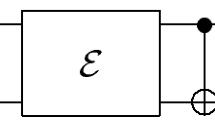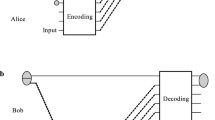Abstract
This paper investigates quantum error correction schemes for fully-correlated noise channels on an n-qubit system, where error operators take the form \(W^{\otimes n}\), with W being an arbitrary \(2\times 2\) unitary operator. In previous literature, a recursive quantum error correction scheme can be used to protect k qubits using \((k+1)\)-qubit ancilla. We implement this scheme on 3-qubit and 5-qubit channels using the IBM quantum computers, where we uncover an error in the previous paper related to the decomposition of the encoding/decoding operator into elementary quantum gates. Here, we present a modified encoding/decoding operator that can be efficiently decomposed into (a) standard gates available in the qiskit library and (b) basic gates comprised of single-qubit gates and CNOT gates. Since IBM quantum computers perform relatively better with fewer basic gates, a more efficient decomposition gives more accurate results. Our experiments highlight the importance of an efficient decomposition for the encoding/decoding operators and demonstrate the effectiveness of our proposed schemes in correcting quantum errors. Furthermore, we explore a special type of channel with error operators of the form \(\sigma _x^{\otimes n}, \sigma _y^{\otimes n}\) and \(\sigma _z^{\otimes n}\), where \(\sigma _x, \sigma _y, \sigma _z\) are the Pauli matrices. For these channels, we implement a hybrid quantum error correction scheme that protects both quantum and classical information using IBM’s quantum computers. We conduct experiments for \(n = 3, 4, 5\) and show significant improvements compared to recent work.


















Similar content being viewed by others
Data Availability
The datasets generated during and/or analysed during the current study are available in the GitHub repository https://github.com/dcpelejo/QECC. We acknowledge the use of IBM Quantum services for this work. The views expressed are those of the authors, and do not reflect the official policy or position of IBM or the IBM Quantum team.
References
Zanardi, P., Rasetti, M.: Noiseless quantum codes. Phys. Rev. Lett. 79, 3306 (1997)
Zanardi, P., Rasetti, M.: Error avoiding quantum codes. Mod. Phys. Lett. B 11, 1085 (1997)
Zanardi, P.: Dissipation and decoherence in a quantum register. Phys. Rev. A 57, 3276 (1998)
Lidar, D.A., Chuang, I.L., Whaley, K.B.: Decoherence-free subspaces for quantum computation. Phys. Rev. Lett. 81, 2594 (1998)
Kempe, J., Bacon, D., Lidar, D.A., Whaley, K.B.: Theory of decoherence-free fault-tolerant universal quantum computation. Phys. Rev. A 63, 042307 (2001)
Lidar, D.A., Bacon, D., Kempe, J., Whaley, K.B.: Protecting quantum information encoded in decoherence-free states against exchange errors. Phys. Rev. A 61, 052307 (2000)
Lidar, D.A., Bacon, D., Kempe, J., Whaley, K.B.: Decoherence-free subspaces for multiple-qubit errors: I: characterization. Phys. Review A 63, 022306 (2001)
Choi, M.-D., Kribs, D.W.: Method to find quantum noiseless subsystems. Phys. Rev. Lett. 96, 050501 (2006)
Knill, E., Laflamme, R., Viola, L.: Theory of quantum error correction for general noise. Phys. Rev. Lett. 84, 2525 (2000)
Fortunato, E.M., Viola, L., Pravia, M.A., Knill, E., Laflamme, R., Havel, T.F., Cory, D.G.: Exploring noiseless subsystems via nuclear magnetic resonance. Phys. Rev. A 67, 062303 (2003)
Viola, L., Fortunato, E.M., Pravia, M.A., Knill, E., Laflamme, R., Cory, D.G.: Experimental realization of noiseless subsystems for quantum information processing. Science 293, 2059 (2001)
Lidar, D.A., Brun, T.A.: Quantum Error Correction. Cambridge University Press (2013)
Kondo, Y., Bagnasco, C., Nakahara, M.: Implementation of a simple operator-quantum-error-correction scheme. Phys. Rev. A 88, 022314 (2013)
Byrd, M.S.: Implications of qudit superselection rules for the theory of decoherence-free subsystems. Phys. Rev. A 73, 032330 (2006)
Gungordu, U., Li, C.K., Nakahara, M., Poon, Y.T., Sze, N.S.: Recursive encoding and decoding of the noiseless subsystem for qudits. Phys. Rev. A 89, 042301 (2014)
Li, C.K., Nakahara, M., Poon, Y.T., Sze, N.S., Tomita, H.: Recursive encoding and decoding of noiseless subsystem and decoherence free subspace. Phys. Rev. A 84, 044301 (2011)
Li, C.-K., Nakahara, M., Poon, Y.-T., Sze, N.-S.: Maximal error correction rates for collective rotation channels on qudits. Quantum Inf. Process. 14, 4039–4055 (2015)
Yang, C.-P., Gea-Banacloche, J.: Three-qubit quantum error-correction scheme for collective decoherence. Phys. Rev. A 63, 022311 (2001)
Li, C.K., Nakahara, M., Poon, Y.T., Sze, N.K., Tomita, H.: Efficient quantum error correction for fully correlated noise. Phys. Lett. A 375, 3255–3258 (2011)
Li, C.K., Lyles, S., Poon, Y.T.: Error correction schemes for fully correlated quantum channels protecting both quantum and classical information. Quant. Inf. Process. 19(5), 153 (2020)
Acknowledgements
We thank Wenxuan Ding, Mikio Nakahara, Yiu-Tung Poon, and Yiyang Zhang for some discussion. We also thank the referee for many helpful suggestions. CK Li is an affiliate member of the Institute for Quantum Computing. His research was supported by the Simons Foundation Grant 851334.
Author information
Authors and Affiliations
Corresponding author
Ethics declarations
Conflict of interest
The authors certify that they have no affiliations with or involvement in any organization or entity with any financial interest or nonfinancial interest in the subject matter or materials discussed in this manuscript.
Additional information
Publisher's Note
Springer Nature remains neutral with regard to jurisdictional claims in published maps and institutional affiliations.
Appendices
Appendix 1: The circuit decomposition in Fig. 2 does not produce the unitary matrix in Fig. 1b
We can construct the simple gates corresponding to \(Y_\theta , Y_{\pi /4}, I_2\otimes I_2\otimes \sigma _z,\) and the three control gates, as \(U_1, U_2, \dots , U_6\) as follows.

So, we see that \(U \ne U_6U_5U_4U_3U_2U_1\).
Appendix 2: Matlab scripts to verify the circuit decompositions of the matrix U
1.1 Decomposition in Fig. 3

1.2 Decomposition in Fig. 5

Appendix 3: Circuits generated by IBMQ
Here we demonstrate how the IBM quantum machines may process the same user-input circuit differently for two separate runs.
See Fig. 19.
Appendix 4: Results from the 5-qubit QECC implementation on the IBM quantum computers
In this appendix, we present more experimental results for the implementation of the 5-qubit QECC presented in Sect. 2.2. Each experiment is run three times in the IBM quantum computers ibmq_valencia, ibmq_santiago, ibmq_vigo, ibmq_5_yorktown, ibmq_ourense and ibmq_athens. The leftmost histograms show the best (least error or highest probability for \(|*0*0*\rangle \)) of the three runs, while the rightmost histogram shows the worst of the three runs (Figs. 20, 21, 22, 23, 24, 25, 26, 27, 28, 29).
Appendix 5
The following illustrate the results obtained in implementing the 4-qubit QECC illustrated in Eq. (12) using \(|q_3q_2\rangle \in \{01,10,11\}\) and the IBM machines ibmq_santiago and ibmq_athens (Figs. 30, 31, 32).
Rights and permissions
Springer Nature or its licensor (e.g. a society or other partner) holds exclusive rights to this article under a publishing agreement with the author(s) or other rightsholder(s); author self-archiving of the accepted manuscript version of this article is solely governed by the terms of such publishing agreement and applicable law.
About this article
Cite this article
Li, CK., Li, Y., Pelejo, D.C. et al. Quantum error correction scheme for fully-correlated noise. Quantum Inf Process 22, 310 (2023). https://doi.org/10.1007/s11128-023-04009-x
Received:
Accepted:
Published:
DOI: https://doi.org/10.1007/s11128-023-04009-x


















